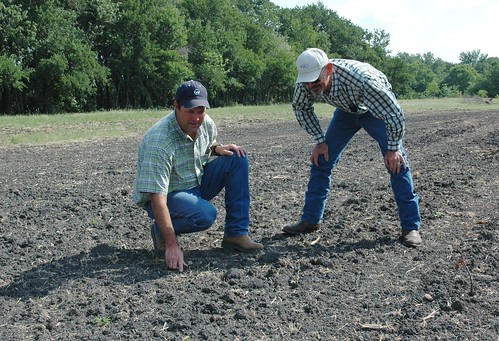
Texas landowners and producers could never have predicted the severe drought conditions this year, which have impacted small and large operations alike. USDA’s Natural Resources Conservation Service (NRCS) is helping many of these ranchers and farmers survive the ongoing drought—including Stuart Fisher, a rancher in Ellis County.
Fisher came to NRCS to develop a conservation plan on his 481-acre, cow-calf operation and gain technical expertise to make his business more successful.
Fisher signed up for NRCS’ Environmental Quality Incentives Program (EQIP) for financial and technical assistance implementing conservation practices. NRCS helped Fisher create terracing to get the landscape ready for grazing and clear 105 acres of brush and mesquite for a pasture that will be used to supply forage for his growing cow-calf operation. New fencing will help Fisher manage a rotational grazing system.
“NRCS has helped me take a neglected piece of land, and turn it into a productive ranch,” Fisher said. “With the limited amount of ranch land available, we have to make each acre as productive and sustainable as possible.”

The conservation plan that NRCS and Fisher began implementing just before the drought started will also help his business get through it. Severe drought has serious implications on the landscape. Not only do bodies of water dry up, but there are other consequences: soil is more prone to erosion, invasive species can more easily gain a foothold and forage is harder to grow.
Some of the hardships Fisher has dealt with are the same as many ranchers in Texas due to the drought, including problems with water quality and quantity and new seedings not establishing and producing forage.
But with NRCS’ help, Fisher established a mixture of drought-tolerant native grasses before the drought. He is now using best practices for clearing brush, laying out a rotational grazing system, selecting sustainable grasses and controlling weeds.
Fisher is also using cover crops to help reduce soil erosion, provide supplemental forage, monitor soil moisture management and provide weed suppression. All of these conservation practices will position his operation to become even more productive once Texas emerges from the drought.
Fisher is already working with NRCS to create more conservation plans for after the drought ends.
Find out more about the Environmental Quality Incentives Program (EQIP)
Check out more conservation stories on the USDA blog
Follow NRCS on Twitter

- Clearing the mesquite was vital on the pasture land for seeding, even though brush piles could not be burned immediately due to drought-related burn bans.

